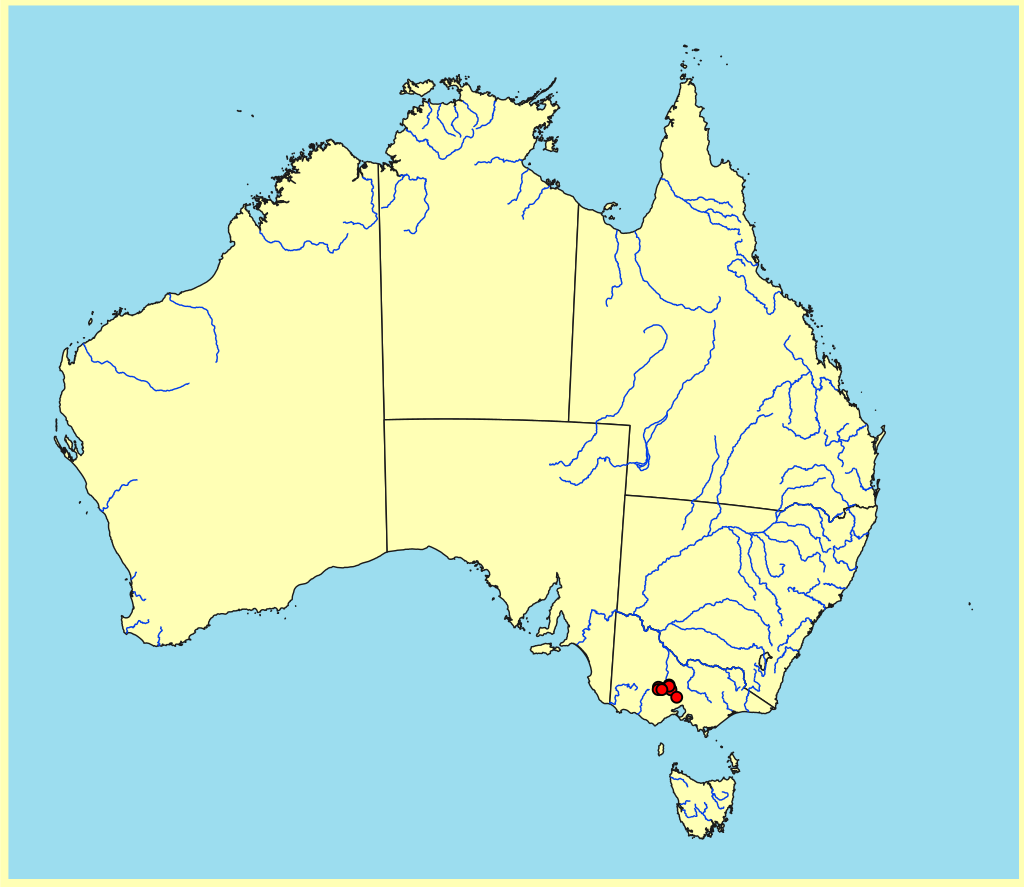Eucalyptus | Eucalyptus | Capillulus | Pachyphloius
Euclid - Online edition
Eucalyptus aurifodina
Eucalyptus aurifodina Rule, Muelleria 30(2) 101-104 (2012).
T: Victoria: Maldon Historic Reserve, ca 200 m N of Smiths Reef Track along Tatt Town Track, 37°01'04"S, 144°06'02"E, K.Rule 3905 & E. Perkins, 30 April 2005; Holotype MEL; isotypes: CANB NSW S.
Small tree to 10 m tall, at times multi-stemmed. Forming a lignotuber.
Bark rough to small branches stringy, grey over red-brown.
Juvenile growth (coppice or field seedlings to 50 cm): stem rounded in cross-section, scabrid for first few leaf pairs, soon becoming smooth; juvenile leaves opposite and sessile for very few pairs, scabrid above and below, becoming alternate, petiolate, ovate, (3)5–8.5 cm long, 2–4 cm wide, margin entire, becoming smooth, thickish, green and glossy.
Adult leaves alternate, petiole 1.2–2 cm long; blade ovate or almost elliptical, 4–8.5 cm long, 1.4–3 cm wide, base oblique, margin entire, thickish, concolorous, glossy, green, side-veins at an acute angle to midrib, moderately reticulate, intramarginal vein parallel to margin, oil glands island.
Inflorescence axillary unbranched, peduncles 0.4–1.3 cm long, buds in umbels of 9 to ?15, pedicels 0.2–0.5 cm long. Mature buds ovoid, ca 0.6 cm long, 0.3 cm wide, yellow, smooth (not warty), scar absent, operculum conical, stamens irregularly flexed, anthers reniform to cordate, versatile, dorsifixed, dehiscing by confluent slits, style long, stigma blunt, locules 3 or 4, the placentae each with 2 vertical ovule rows. Flowers white.
Fruit pedicellate (pedicels to 0.2–0.5 cm), hemispherical, 0.3–0.5 cm long, 0.5–0.9 cm wide, disc raised or level, valves 3 or 4, slightly exserted or near rim level.
Seeds blackish, 1.5–2 mm long, pyramidal or obliquely pyramidal, dorsal surface smooth, hilum terminal.
Cultivated seedlings (measured at ca node 10): cotyledons reniform; (after Rule (2012): stems rounded in cross-section, stellate-hairy; leaves sessile ovate, not measured, discolorous, green above, paler on underside., stellate-hairy.
Flowering has been recorded in April.
A small stringybark tree endemic to the Midlands region of Victoria, occurring in woodlands on shallow soil over sedimentary rock, sporadically in the Maldon, Carisbrook, Gisborne area. It has stringybark to the small branches and a crown of small glossy thick-textured leaves.
Eucalyptus aurifodina is one of 3 species of brown stringybark, the others being E. baxteri and E. arenacea. E. baxteri differs from E. arenacea and E. aurifodina by having short stout peduncles, no pedicel or if present < 0.2 cm long, and larger buds with a conspicuously warty operculum. Both E. arenacea and E. aurifodina have slender peduncles and pedicels longer than those of E. baxteri, and the smaller mature buds lack warts. Within populations of each of the three species there is some variation in fruit width but generally E. baxteri has the largest fruit (0.7–1.8 cm wide), E. arenacea (0.7–1.2 cm wide) and E. auifodina (0.5–0.9 cm wide).
To clearly separate E. aurifodina from E. arenacea is less easy with the smaller-leaved crown, non-warty mature buds and generally smaller fruit being the best guide along with distribution and habitat. The former is a small tree of "goldfields woodlands" (woodlands west of Castlemaine that were cutover heavily in the 19th century) and the latter a species of drier sandy tracts often as an emergent tree in mallee heath.






